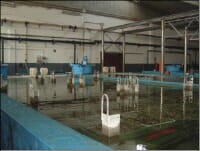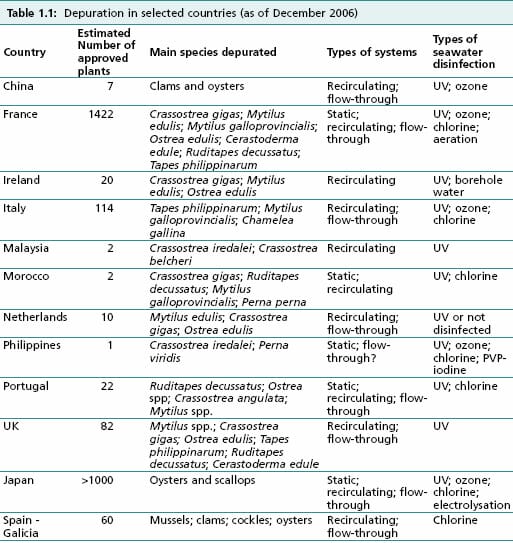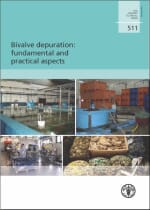Depuration (purification) is a technique applied in many parts of the world for the removal of microbial contaminants from light to moderately contaminated bivalve molluscan shellfish by placing them in tanks of clean seawater such that they undertake their normal pumping activity for a period of time that may range from several hours to days (see Part 3 for more details). It is usually undertaken because it is required by regional, national or local legislation but may also be applied at the discretion of the industry to protect their customers, demonstrate due diligence, or to satisfy the requirements of legislation in other regions or counties in order to be able to export to these.
In Europe there is a long history of the use of the process to overcome the problems caused by faecal contamination of shellfish harvesting areas due to the large numbers of people living in coastal locations and to extensive animal husbandry. While there is also a long history of depuration in the United States of America, the wider availability of relatively pristine coastal waters there has allowed greater attention to be placed on harvest of shellfish from such locations rather than removal of contamination postharvest. Depuration has also been practiced relatively extensively in Australia and Japan, but to a limited extent in New Zealand. In general, shellfish marketed commercially in many other parts of the world have not been subject to specific hygiene requirements and thus depuration has not been practised in these areas.
The purpose of this manual is to give guidance to industry on the construction and operation of depuration systems together with aspects of monitoring the depuration process. The principle factors affecting the effectiveness of depuration are the design of the system itself, quality of the seawater used in it, the way that the system and allied processes are operated and the provision of the right physiological conditions for the shellfish for a sufficient length of time. All of these factors will be examined, and the associated requirements of legislation will be identified for a number of countries around the world. The justification for concentration on the requirements of the European Union (EU) and United States of America is that these two trading blocks tend to drive many of the controls applied in other countries which wish to export shellfish to them.

Although depuration is based on the provision of the correct physiological conditions for the shellfish to undertake their pumping activity, peak effectiveness for microbiological removal, especially of viruses, occurs within a narrower range than that over which the shellfish exhibit such activity. Limits for variables such as temperature and dissolved oxygen given in the literature or stipulated by regulatory bodies may therefore not yield optimum removal of the pathogens. For example, it is known that depuration of viruses from Pacific oysters (Crassostrea gigas) is much more effective at 18 °C than at 8 °C in northern temperate countries.
Depuration will only remove light to moderate levels of microbial contaminants and cannot be used for heavily contaminated shellfish. There are also limitations as to the types of microbes that can be successfully removed by the process and these limitations will be emphasized.
In general, the best approach to the production of safe shellfish is to grow them in, and/or harvest them from, areas where the water is not subject to faecal contamination (Approved areas under the US system and class A areas under the EU system; see Section 2.3). The use of depuration in addition to harvesting from clean areas will ensure that the risk of illness from contaminants of faecal origin will be as low as can be practically achieved without thorough cooking.
Other considerations that need to be taken into account with regard to production of safe shellfish are the presence of naturally occurring pathogenic vibrios, phytoplanktonassociated biotoxins and chemical contaminants such as heavy metals and organic chemicals. These latter contaminants will be considered briefly in Section 3. Some general information on the extent and nature of depuration undertaken in a number of countries is summarized in Table 1.1.

This manual is primarily intended to provide information to current or prospective members of the shellfish industry who do not have experience of depuration but are contemplating setting up a depuration plant (Figure 1.1). However, it may also provide additional information to members of the industry whose experience is limited with respect to the variety of systems and practices. It is also intended to provide background information for fishery officers and public health officials who deal with the shellfish industry.
Further Reading
| - | You can view the full FAO report by clicking here. |
November 2008


